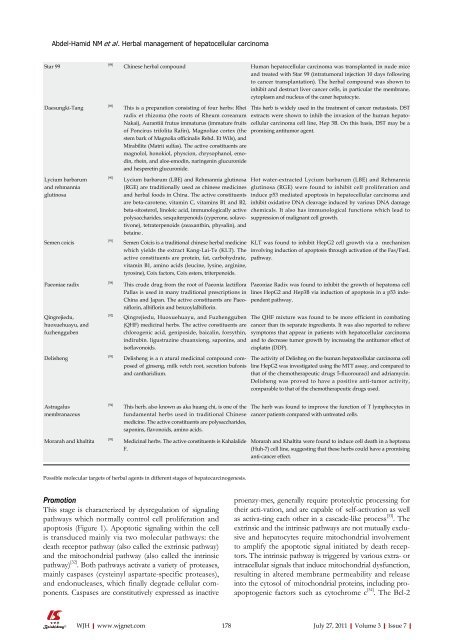7 - World Journal of Gastroenterology
7 - World Journal of Gastroenterology
7 - World Journal of Gastroenterology
- No tags were found...
Create successful ePaper yourself
Turn your PDF publications into a flip-book with our unique Google optimized e-Paper software.
Abdel-Hamid NM et al . Herbal management <strong>of</strong> hepatocellular carcinomaStar 99[88]Chinese herbal compoundHuman hepatocellular carcinoma was transplanted in nude miceand treated with Star 99 (intratumoral injection 10 days followingto cancer transplantation). The herbal compound was shown toinhibit and destruct liver cancer cells, in particular the membrane,cytoplasm and nucleus <strong>of</strong> the caner hepatocyte.Daesungki-TangLycium barbarumand rehmanniaglutinosaSemen coicisPaeoniae radixQingrejiedu,huoxuehuayu, andfuzhenggubenDelisheng[89][90][91][58][92][93]This is a preparation consisting <strong>of</strong> four herbs: Rheiradix et rhizoma (the roots <strong>of</strong> Rheum coreanumNakai), Aurantiii frutus immaturus (immature fruits<strong>of</strong> Poncirus trifolita Rafin), Magnoliae cortex (thestem bark <strong>of</strong> Magnolia <strong>of</strong>ficinalis Rehd. Et Wils), andMirabilite (Matrii sulfas). The active constituents aremagnolol, honokiol, physcion, chrysophanol, emodin,rhein, and aloe-emodin, naringenin glucuronideand hesperetin glucuronide.Lycium barbarum (LBE) and Rehmannia glutinosa(RGE) are traditionally used as chinese medicinesand herbal foods in China. The active constituentsare beta-carotene, vitamin C, vitamins B1 and B2,beta-sitosterol, linoleic acid, immunologically activepolysaccharides, sesquiterpenoids (cyperone, solavetivone),tetraterpenoids (zeaxanthin, physalin), andbetaine .Semen Coicis is a traditional chinese herbal medicinewhich yields the extract Kang-Lai-Te (KLT). Theactive constituents are protein, fat, carbohydrate,vitamin B1, amino acids (leucine, lysine, arginine,tyrosine), Coix factors, Coix esters, triterpenoids.This crude drug from the root <strong>of</strong> Paeonia lactifloraPallas is used in many traditional prescriptions inChina and Japan. The active constituents are Paeoniflorin,albiflorin and benzoylalbiflorin.Qingrejiedu, Huoxuehuayu, and Fuzhengguben(QHF) medicinal herbs. The active constituents arechlorogenic acid, geniposide, baicalin, forsythin,indirubin. ligustrazine chuanxiong, saponins, andis<strong>of</strong>lavonoids.Delisheng is a n atural medicinal compound composed<strong>of</strong> ginseng, milk vetch root, secretion bufonisand cantharidium.This herb is widely used in the treatment <strong>of</strong> cancer metastasis. DSTextracts were shown to inhib the invasion <strong>of</strong> the human hepatocellularcarcinoma cell line, Hep 3B. On this basis, DST may be apromising antitumor agent.Hot water-extracted Lycium barbarum (LBE) and Rehmanniaglutinosa (RGE) were found to inhibit cell proliferation andinduce p53 mediated apoptosis in hepatocellular carcinoma andinhibit oxidative DNA cleavage induced by various DNA damagechemicals. It also has immunological functions which lead tosuppression <strong>of</strong> malignant cell growth.KLT was found to inhibit HepG2 cell growth via a mechanisminvolving induction <strong>of</strong> apoptosis through activation <strong>of</strong> the Fas/FasLpathway.Paeoniae Radix was found to inhibit the growth <strong>of</strong> hepatoma celllines HepG2 and Hep3B via induction <strong>of</strong> apoptosis in a p53 independentpathway.The QHF mixture was found to be more efficient in combatingcancer than its separate ingredients. It was also reported to relievesymptoms that appear in patients with hepatocellular carcinomaand to decrease tumor growth by increasing the antitumor effect <strong>of</strong>cisplatin (DDP).The activity <strong>of</strong> Delishng on the human hepatocellular carcinoma cellline HepG2 was investigated using the MTT assay, and compared tothat <strong>of</strong> the chemotherapeutic drugs 5-fluorouracil and adriamycin.Delisheng was proved to have a positive anti-tumor activity,comparable to that <strong>of</strong> the chemotherapeutic drugs used.AstragalusmembranaceusMorarah and khaltita[94][95]This herb, also known as aka huang chi, is one <strong>of</strong> thefundamental herbs used in traditional Chinesemedicine. The active constituents are polysaccharides,saponins, flavonoids, amino acids.Medicinal herbs. The active constituents is KahalalideF.The herb was found to improve the function <strong>of</strong> T lymphocytes incancer patients compared with untreated cells.Morarah and Khaltita were found to induce cell death in a heptoma(Huh-7) cell line, suggesting that these herbs could have a promisinganti-cancer effect.Possible molecular targets <strong>of</strong> herbal agents in different stages <strong>of</strong> hepatocarcinogenesis.PromotionThis stage is characterized by dysregulation <strong>of</strong> signalingpathways which normally control cell proliferation andapoptosis (Figure 1). Apoptotic signaling within the cellis transduced mainly via two molecular pathways: thedeath receptor pathway (also called the extrinsic pathway)and the mitochondrial pathway (also called the intrinsicpathway) [32] . Both pathways activate a variety <strong>of</strong> proteases,mainly caspases (cysteinyl aspartate-specific proteases),and endonucleases, which finally degrade cellular components.Caspases are constitutively expressed as inactiveproenzy-mes, generally require proteolytic processing fortheir acti-vation, and are capable <strong>of</strong> self-activation as wellas activa-ting each other in a cascade-like process [33] . Theextrinsic and the intrinsic pathways are not mutually exclusiveand hepatocytes require mitochondrial involvementto amplify the apoptotic signal initiated by death receptors.The intrinsic pathway is triggered by various extra- orintracellular signals that induce mitochondrial dysfunction,resulting in altered membrane permeability and releaseinto the cytosol <strong>of</strong> mitochondrial proteins, including proapoptogenicfactors such as cytochrome c [34] . The Bcl-2WJH|www.wjgnet.com 178July 27, 2011|Volume 3|Issue 7|

















